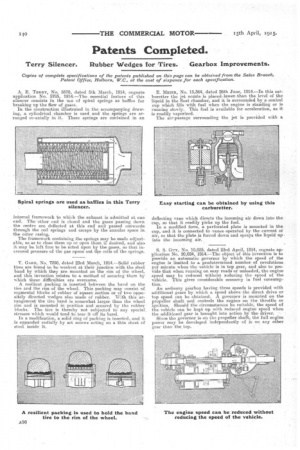Patents Completed.
Page 20

If you've noticed an error in this article please click here to report it so we can fix it.
Terry Silencer. Rubber Wedges for Tires. Gearbox Improvements.
Copies of complete specifications of the patents published on this page can be obtained from the Sales Branch, Patent Office, Holborn, WC-, at the cost of sixpence for each specification.
A. E. TERRY, No. 5578,. dated 5th March, 1914, cognate application No. 5785, 1914.—The essential feature ef this silencer consists in the use of spiral springs as baffles for breaking up the flow of gases. In the construction illustrated in the accompanying drawing, a cylindrical chamber is used and the springs are arranged co-axially in it. These springs are contained in an
internal fran-iework to -which the exhaust is admitted at one end. The other end is closed and the gases passing down the centre are deflected at this end: and passed outwards through the coil springs and escape by the annular space in the outer casing.
The framework containing the springs may be made adjustable, so as to close them up or open them if desired, and also it may be left free to be acted upon by the gases, so that increased pressure of the gas opens out the coils of the springs.
T. GARE, No. 7250, dated 23rd March, 1914.—Solid rubber tires are•found-to be weakest at their junction with the steel band by which they are mounted on the rim of the wheel, and this invention relates to a method of securing them hy which these difficulties are overcome.
A resilient packing is inserted between the band on the tire and the rim of the wheel. This packing may consist of segmental blocks of rubber of square section or ci two -oppositely directed wedges also made of rubber. Wit'h this ariangement the tire band is somewhat larger than the wheel rim and is mounted in position and 'secured by the rubber blocks. The tire is thereby not subjected to any special stresses which would tend to tear it off its band.
In a modification, a solid ring of packing is inserted, and it. is expanded radially by set screws acting on a thin sheet of steel inside it.
E. METER, No. 15,364, dated 26th June, 1914.--In this carburetter the jet nozzle is placed,lower-than the level of the liquid, in the float chamber, and it is surrounded by a conical cup which fills with fuel when the engine is standing or is running slowly. This fuel is available for acceleration, as it is readily vaporized.
The air-passage surrounding the jet is provided with a deflecting vane which directs the incoming air down into the cup, so that it readily picks up the fuel.
In a modified form, a perforated plate is mounted in the cup, and it is connected to vanes operated by the current of air, so that the plate is forced down and sprays the liquid up into the incoming air.
S. S. Guy, No. 10,025. dated 23rd April, 1914, cognate application No. 20,024, 1914;—The object of this invention is to provide an autoinatio governor by which the speed of the engine is limited to a predetermined number of revolutions per minute when-the -vehicle is intop gear, and also to provide that when running on easy roads or unloaded, the engine speed may be reduced without seducing the speed of the vehicle. This gives considerable economy in fuel consumption.
An ordinary gearbox having three speeds is provided with additional gears by which a speed above-the direct drive or top speed can be obtained. A. governor is mounted on the propeller shaft and controls the engine on the throttle or ignition. Should the circumstances be suitable, the speed of the vehicle can be kept up with reduced engine speed when the additional gear is brought into action by the driver. - Since the governor is on the propeller Shaft; the full engine power may be developed independently of it, on any other gear than the top.




















